
Pezibear / Pixabay
“Where quality is the thing sought after, the thing of supreme quality is cheap, whatever the price one has to pay for it.” – William James
For many, coffee can only be enjoyed when they know that the production of it hasn’t had significant environmental and human costs. To help such concerned consumers find ethical coffee, various organizations have begun to certify producers and label coffee according to standards of stewardship. For those who want to drink coffee that doesn’t hurt the environment or the people who produce it, these labels help direct them to this coffee.
The Fair Trade label indicates that the producers and workers in developing countries have received a fair price for their coffee and a fair wage for their labour. The rap against Fair Trade coffee is that it is restricted to small, family run farms, and, even though there are larger, non-family run farms that produce coffee ethically. Furthermore, there is nothing stopping greedy merchants from taking advantage of well-intentioned consumers by charging exorbitant prices for coffee bearing the label. These concerns may be valid, but a third is not. The objection that Fair Trade coffee isn’t quality coffee is misapplied; average ratings given to Fair Trade coffees by professional tasters are the same as those of other specialty coffees, and they are on the rise.
The Certified Organic label means that the coffee wasn’t grown using pesticides, chemical fertilizers or genetically modified seeds. Bird Friendly and Rainforest Alliance-Certified Shade Grown coffee labels mean that it was grown using traditional methods so that trees on coffee plantations are preserved, rather than clear-cut. The Rainforest Alliance has begun to certify coffee producers who raise coffee in areas that have been deforested if these producers are pursuing a program to return trees into these clear cuts and cultivating coffee in the shade.
There is another way you can be reasonably assured that your coffee is produced ethically—simply drink great coffee. The idea here is to pay a higher price for a higher quality and by doing so, rewarding the most committed growers. Great coffee is not grown in the full sun of a clear cut and doused with chemicals. Great coffee requires great care at every step of the process. There’s a wonderful principle at work here. The best coffee is produced using methods and means that respect the people who grow it and the environment in which it is grown. It’s as if justice and natural law have been fused.
*
Suzanne, a friend of mine, has visited Honduras twice in the last three years. She did so as a member of her church’s Missions Team. She was struck by the poverty she saw there. In order to eat, entire families worked on the coffee plantations and were paid almost nothing. Suzanne believes that if the adults received an adequate wage, the young children would be able to go to school and the cycle of poverty would be broken.
The Missions Team, believing that serving ethical coffee was essential to supporting the coffee producing communities, like those in Honduras, convinced the church leadership to switch to Fair-Trade coffee. They agreed, but Suzanne now wonders if perhaps they agreed because they believed, as do the corporate advertisers, that ethical coffee was chic and would be an attractant of sorts. When Suzanne’s church began a large building project, there was an over-all increase in donations, but less was directed to church ministries. Cuts were necessary. They switched to a less expensive coffee.
*
Residents of Abbotsford, BC, where I live, are the most generous people in Canada. Their contribution to charities is more than double the national average. One explanation is that the community is very religious. My experience with the religious community in Abbotsford is that they will, in a flash, write a cheque to help a school in Nicaragua or a water project in Guatemala. But, all the while, they go home and make a pot of coffee from a can, not realizing how much they could help those very communities by switching to good coffee.
They buy the cheaper product because they are good people with a commitment to stewardship, unaware of the global effect of their purchase habits.
*
What about Starbucks? Starbucks has good coffee.
If you are concerned with the social and environmental effects of coffee production, your choice between buying Starbucks and corporate canned coffee is clear—buy Starbucks. Starbucks does deserve some thanks. Although it was unintentional, they have helped the plight of the coffee grower. In their quest for profits, they have given us a taste for good quality coffee. When I had my first sip of Starbucks, I thought it was too strong and too bitter. By the time I finished that cup, I realized there was much more to coffee than caffeine and a bit of warmth; I realized I loved coffee. It was Starbucks that helped me to see coffee as more than a caffeinated brown liquid. And by introducing me to good coffee, they put me on a quest for a great one.
But, to whom should Starbucks be compared? If you are comparing Starbucks to a small roaster—again, the choice is clear—don’t buy Starbucks. Because there are so many good coffees to experience, it seems a shame to limit oneself to Starbucks’ Pike’s Place blend. Further, the variation found in the coffee be reflected in the environment we drink it in. Since when did conformism become a core American value so that the coffee shop needs to look exactly the same in Seattle as it does in Soho—or worse yet, the same in Vegas as in Venice.
*
On Saturday mornings, I often accompany my wife to the local farmer’s market, an excursion made much more attractive since Grab-A-Java set up a booth. Grab-A-Java, “a small-batch, wholesale micro-roaster,” is owned and operated by Dave Perrit. I visited his roaster one cold November afternoon. The small black roaster squats in the middle of a room in his house. It is warm and the hum of the fans swirl the woody aroma of the roasting coffee beans. Dishevelled piles of labels run along the counter which is shared by large bins filled with freshly roasted coffee. His coffee comes from one supplier, Organic Products Trading Co. (OPTCO), which sources green coffee from all over the world. All the beans are both Free Trade and Certified Organic, but they are special in another way. They are Café Femenino beans.
Café Femenino is a cooperative formed in 2004 by women in Northern Peru who were searching to improve the lives of their families as well as to gain some control of the coffee they worked so hard to produce. To sell coffee from Café Femenino, a roaster must commit to contributing to local women’s shelters and/or the Café Femenino Foundation. Grab-A-Java supports both. This concept is spreading to existing co-ops in Columbia, Nicaragua, Mexico, Dominican Republic, Brazil and Guatemala, and soon to be introduced in Rwanda.
*
In 1999, I watched a bandana-masked protester heave a USA Today newspaper box through the window of a Starbucks during the World Trade Organization riots in Seattle. This attack wasn’t just random window breaking—it had targeted the coffee shop. At the time I was disgusted by the lack of respect for property and authority. But one question lingered: What are they so mad about? Since then, I have heard things, dark whisperings about coffee and third-world exploitation. I worry that maybe righteous anger is the appropriate response, and I should indignantly slam my coffee cup (empty) into the bin. But I love coffee. Coffee is why I get up in the morning; it’s why I can teach writing to 16 year olds in the last class of the day; it’s why I am willing to run errands after work. But I also desire to do what’s right and good, so I have endeavored here to find out if there is such a thing as an ethical cup of coffee.
It turns out there is—a great one, best served with a home-made chocolate-chip cookie.
Coffee and Conscience (1)–Creation
Coffee and Conscience (2)–Fall
Other resources:
Bacon, Chris. “Confronting the Coffee Crisis.” World Development. 33:3 (2004) : 497-511.
Ball, Barbara. Coffee Talk: Sharing Christ Through Friendly Gatherings. San Bernardino: Churches Alive!, 1979.
“The Coffee Addiction.” Scott Wapner. CNBC, Shaw Cable, West. 29 Sept. 2011. Television.
Capon, Robert Farrar. The Supper of the Lamb: A Culinary Reflection. New York: HJB, 1969.
Davids Kenneth. “Starting with Cans: Mainstream Supermarket Coffees.” Coffee Review. Jan. 2007. Web. 5 Nov. 2011
Ditto, Jason. 2basnob.com. “Coffee Tasting” n.p. 2008. Web. 12 Oct. 2011.
Ellison, Katherine . “Can Great Coffee Save the Jungle?” Smithsonian 35. 3 (2004) : 100-107.
Gaudio, Rudolf P. “Coffee Talk: StarbucksTM and the Commercialization of Casual Conversation.” Language in Society. 32:5 (2003) : 659-691.
Karris, Robert J. Eating Your Way Through Luke’s Gospel. Collegeville: Liturgical Press, 2006.
Leonard, Annie. The Story of Stuff. Free Range Studios, 2007
Moguel, Patricia and Victor Toledo. “Biodiversity Conservation in Traditional Coffee Systems in Mexico.” Conservation Biology. 13.1 (1999) : 11-21.
Murray, Douglas L. “The future of Fair Trade Coffee: dilemma’s facing Latin America’s small scale producers.” Development in Practice. 16.2 (2006) : 171-192.
“Pencils, Metal Recycling, Coffee.” How Its’ Made. Discovery. Shaw Cable, West. 12 Oct. 2011.
Rottenberg, James A. “Ecological Role of a Tree [Gamelina Arborea] Plantation in Guatemala.” The Auk. 124.1 (2007): 316-330.
Steer, Simon M. Eating Bread in the Kingdom of God. Diss. Westminster Theological Seminary, 2002. Ann Arbor: UMI, 2002.



